Flaky, buttery croissant bread requires time, precision, and patience, but is a very rewarding baking project that will make your kitchen smell like a French boulangerie. (And is there any better smell than fresh bread?) I know making homemade pastry can seem intimidating, but I thoroughly break down the process for you, step by step, in the tutorial below. Any home baker—like me or you—can accomplish this.
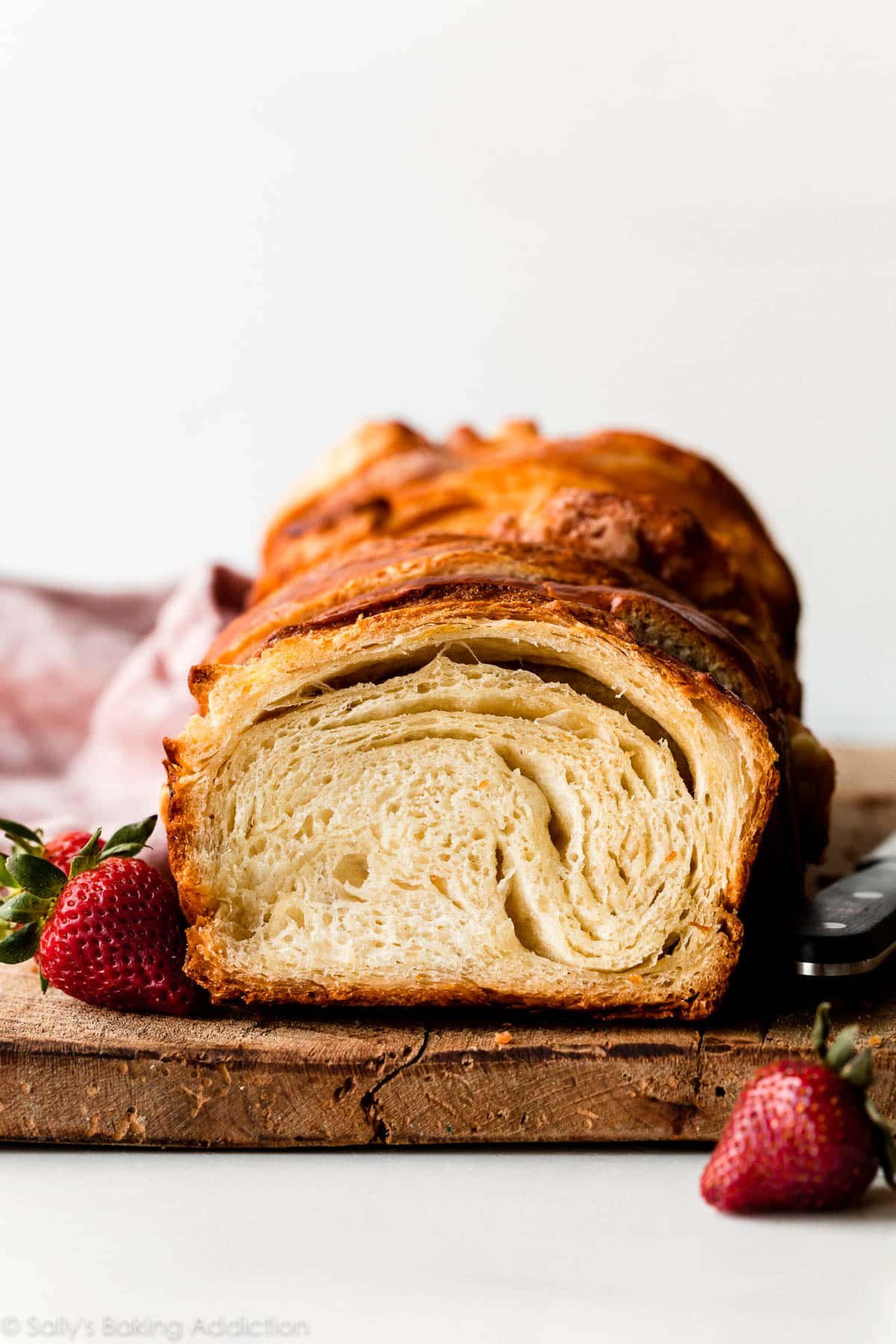
What is Croissant Bread?
Croissant bread is exactly what it sounds like: croissant dough baked as bread. My inspiration for this recipe was this croissant loaf on Food52, but I used a scaled-down version of my own homemade croissants dough to produce just 1 loaf. Though I can’t promise how long your loaf will last… it doesn’t last long in my house! The other difference in my croissant bread recipe is we’re going to roll up the dough first, and then cut into rolls, instead of cutting strips and individually rolling them.
The result is an impressive loaf version of everyone’s favorite yeasted pastry, which smells and tastes like a croissant, but slices like bread. Incredible on its own, but try it as a grilled cheese, BLT, toasted with jam, or in your favorite breakfast strata recipe or French toast casserole!
Croissant Bread Details
- Texture: The texture of this croissant bread is melt-in-your-mouth soft and tender, with a crispy, flaky crust. Because it’s baked as bread in a loaf pan, it’s not quite as layered and crust-shattery (technical terms) as croissants, but it’s still very airy.
- Flavor: Blissfully buttery and slightly sweet—just try to keep your eyes from closing when you taste this, I’m not sure it’s possible!
- Ease: The great news is that making croissant bread is easier than making individual croissants. It requires no special ingredients, but it does require 3 rounds of 20-minute refrigerations and 2 rises. For these reasons, I categorize this as an advanced baking recipe. But I’m here to walk you through each step. You can absolutely make this!
- Time: Plan for this recipe to take just under 6 hours, plus some cooling time, which is considerably shorter than 12+ hours for my individual croissants. There’s resting time between most steps, which means most of the time is hands off. To develop all those flaky pastry layers, croissant dough needs to rest in the refrigerator often. It likes to nap, if you will.
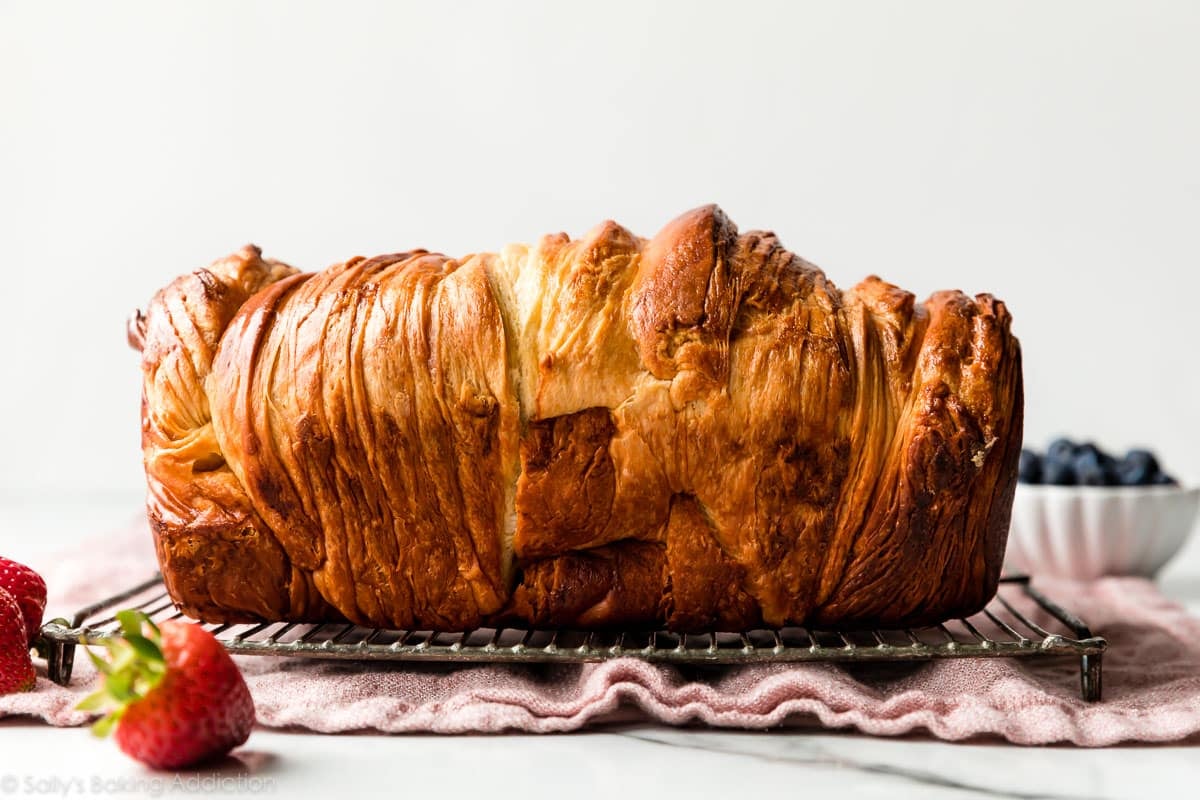
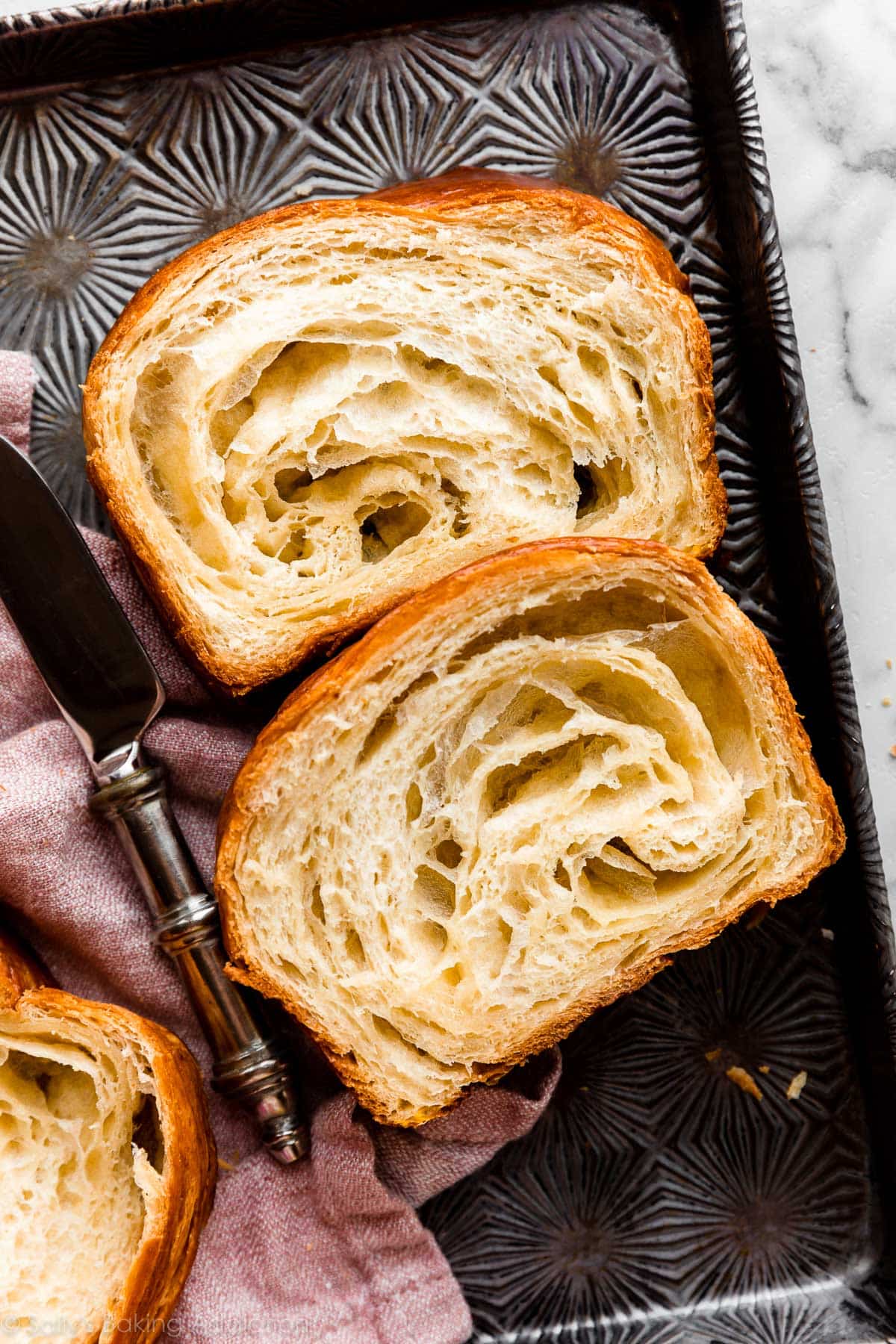
Only 7 Ingredients Total
You need just 6 simple ingredients for the croissant bread dough: flour, butter, salt, yeast, milk, and sugar. The 7th ingredient is an egg to make an egg wash for brushing over the top to get that glossy golden sheen on the top of the loaf—much like pie crust and stromboli.
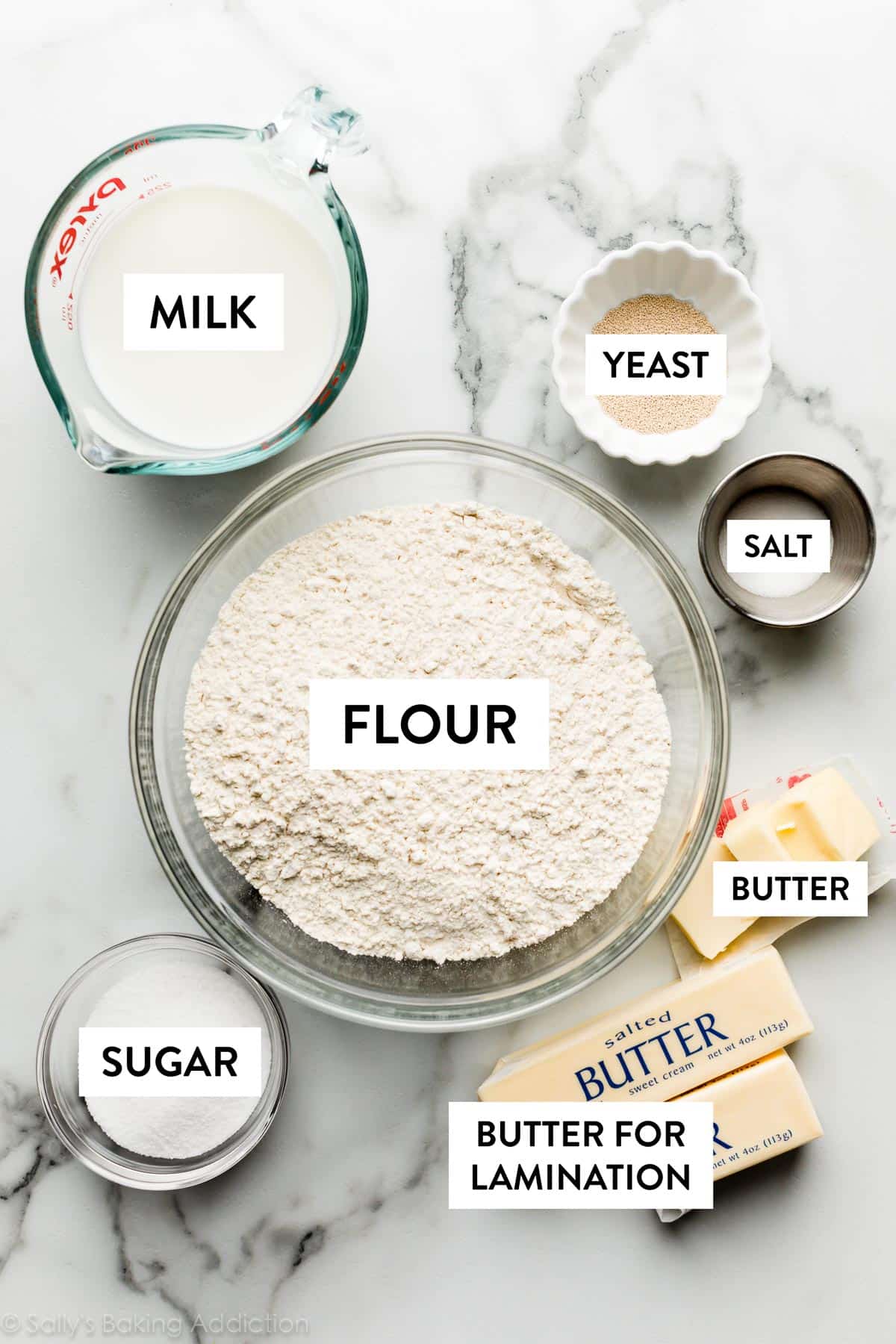
What is Laminated Dough?
Laminating dough is the process of folding butter into dough many times, which creates multiple alternating layers of butter and dough. (Similar to how we make biscuits, cheddar biscuits, and rough puff pastry, though today’s dough includes yeast.) When the laminated dough bakes, the butter melts and creates steam. This steam lifts the layers apart, giving us dozens of flaky, airy, buttery layers.
In my regular croissants and chocolate croissants recipes, we mix butter and flour together to make a butter block. With today’s croissant bread recipe, however, we’re lining pieces of butter down the dough so there’s no compact butter block needed.
4 Tips for Laminating This Dough
- It’s OK if there are air bubbles in the dough; your rolling pin will pop them.
- If the dough tears and butter is exposed, just sprinkle the exposed butter with flour.
- If the dough is impossible to roll, try flipping it over. If it’s still impossible to roll, cover and let it rest for 5 minutes before trying again, to let the gluten relax.
- There are 3 rounds of 20-minute refrigerations. Do NOT extend these times because the yeasted dough will puff up too much. The timer is your friend here!
Video & Photos: How to Make Croissant Bread
The full printable recipe is below, but this recipe involves quite a few steps, so I’m going to walk you through it with step-by-step photos. I’m leaving out photos of preparing the dough because you can see it come together in the video tutorial. I also have a separate video tutorial for How to Knead Dough, if you need extra help with that step.
Here is the dough after the 1st rise and then after you punch it down:
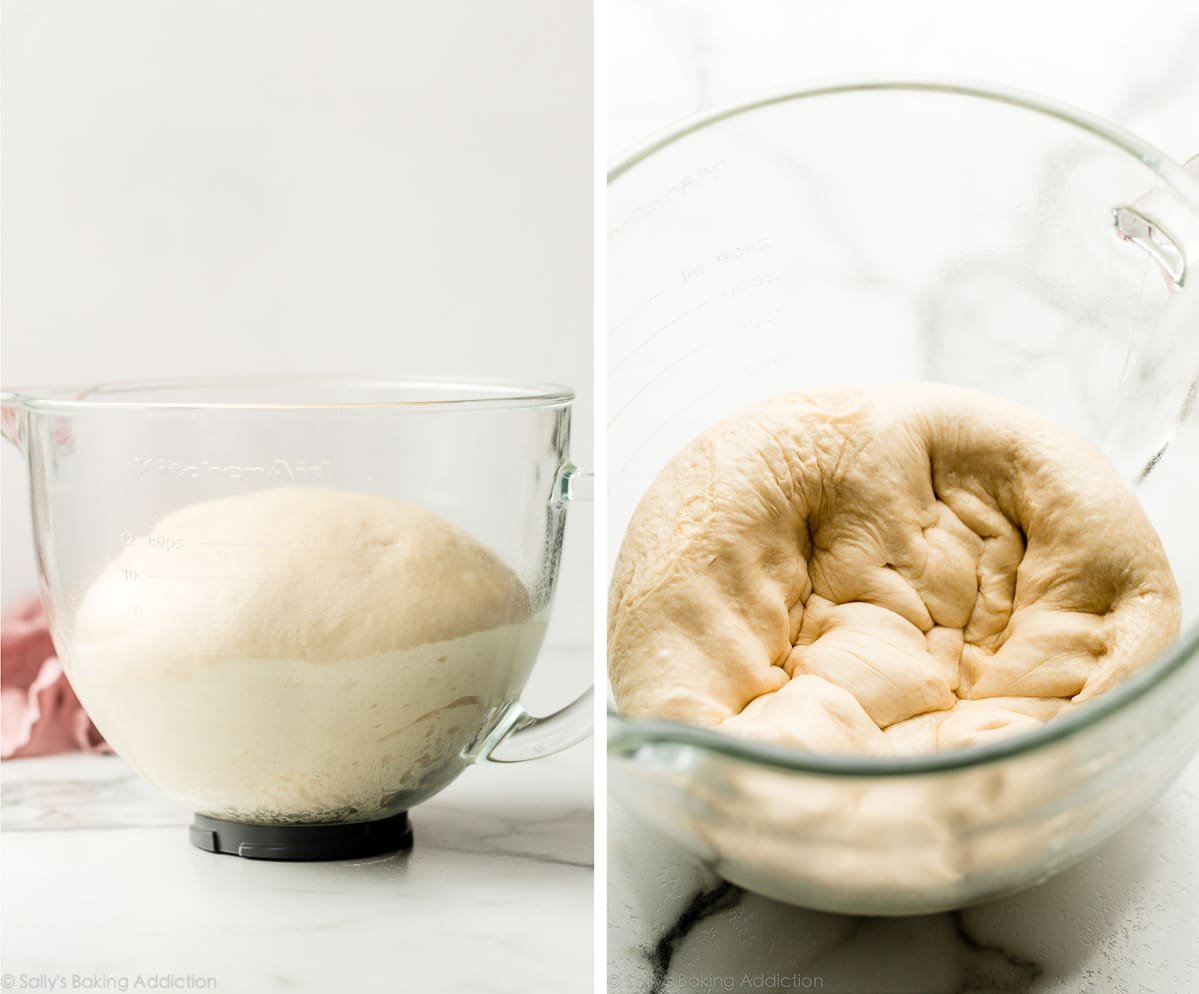
Now it’s time to flatten the dough and prepare it for lamination. Gently flatten the dough out into a 10×14-inch (25x35cm) rectangle using lightly floured hands to carefully stretch the dough. I recommend flattening it right onto a nonstick surface so you can literally pick it all up without the dough losing shape. Refrigerate this flattened dough for 20 minutes:
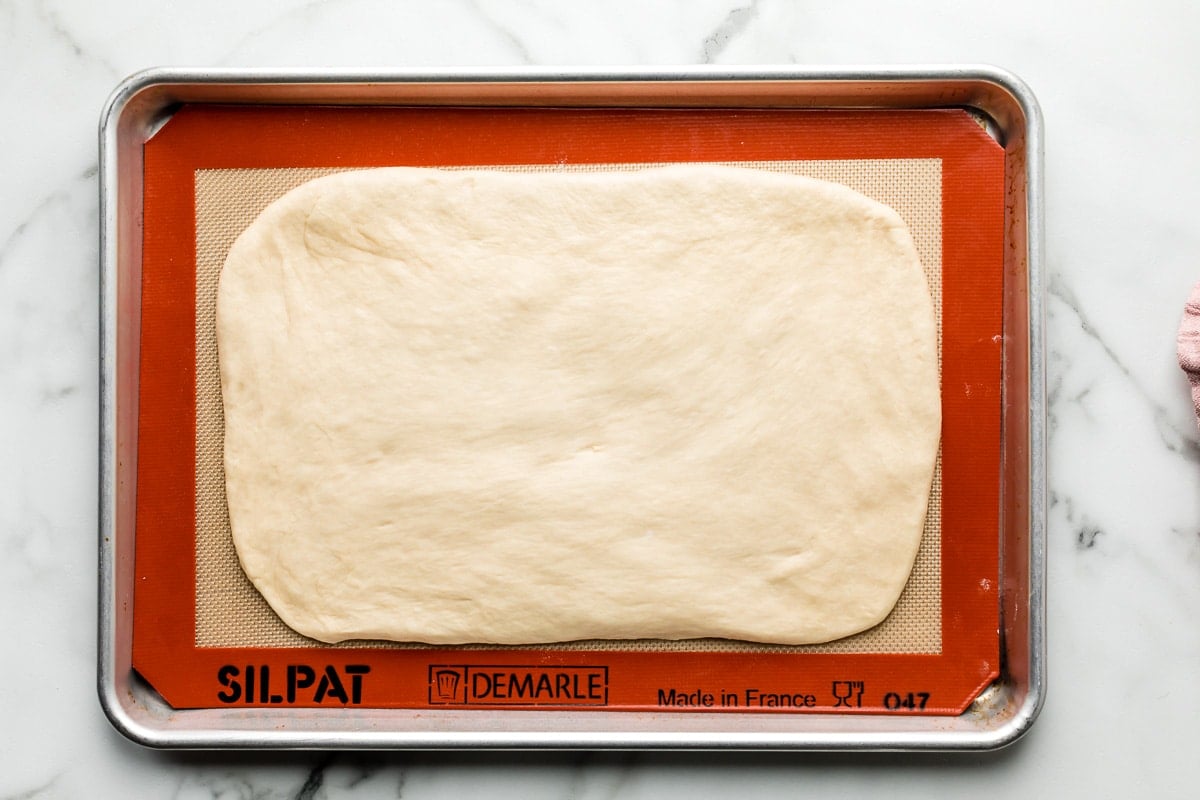
After 20 minutes in the refrigerator, the dough is about as pliable as the butter. Line the butter down the center third of the dough as pictured:
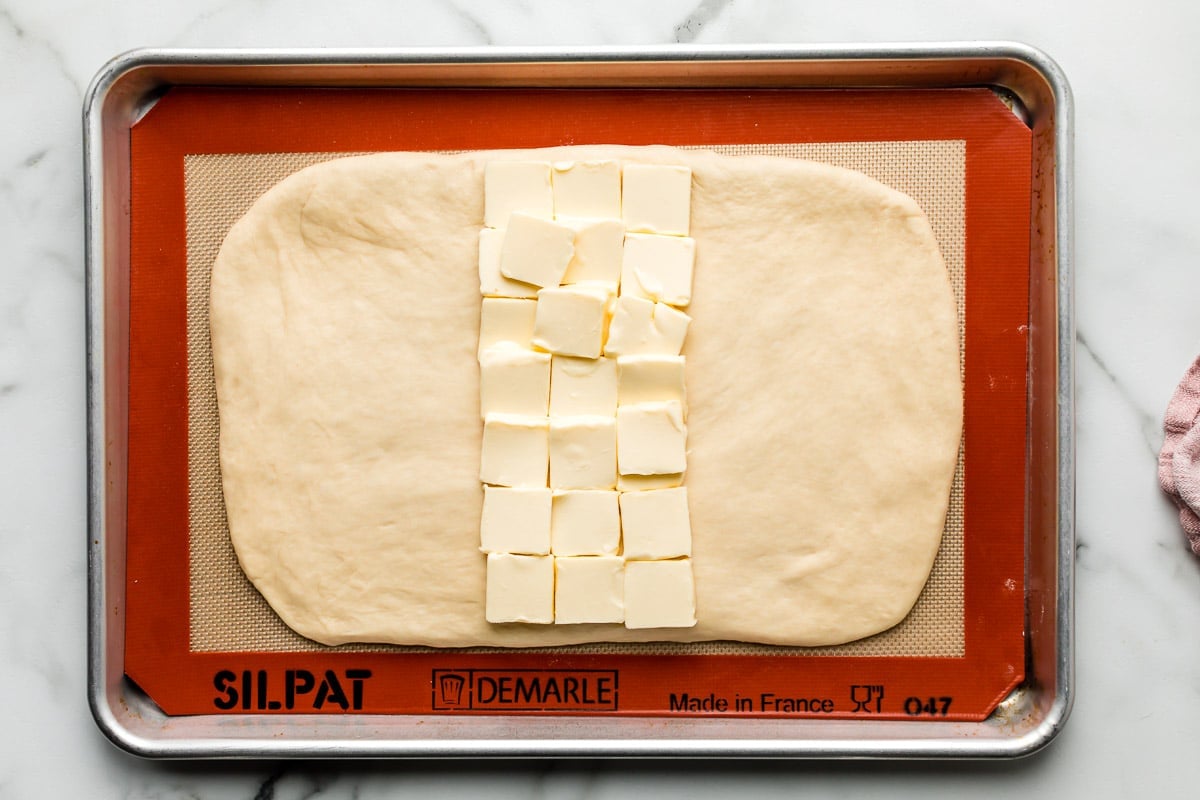
1st lamination: Fold one side over the butter:
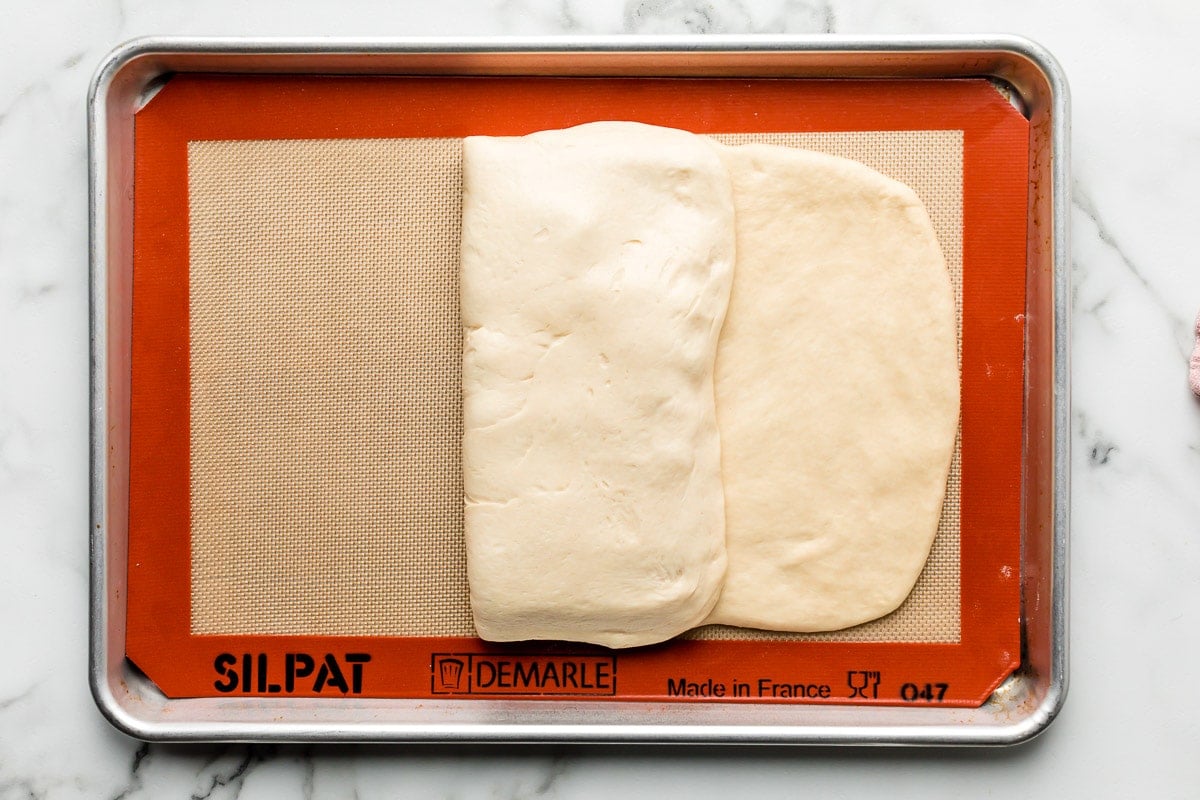
Fold the other side over that, like you would fold a business letter:
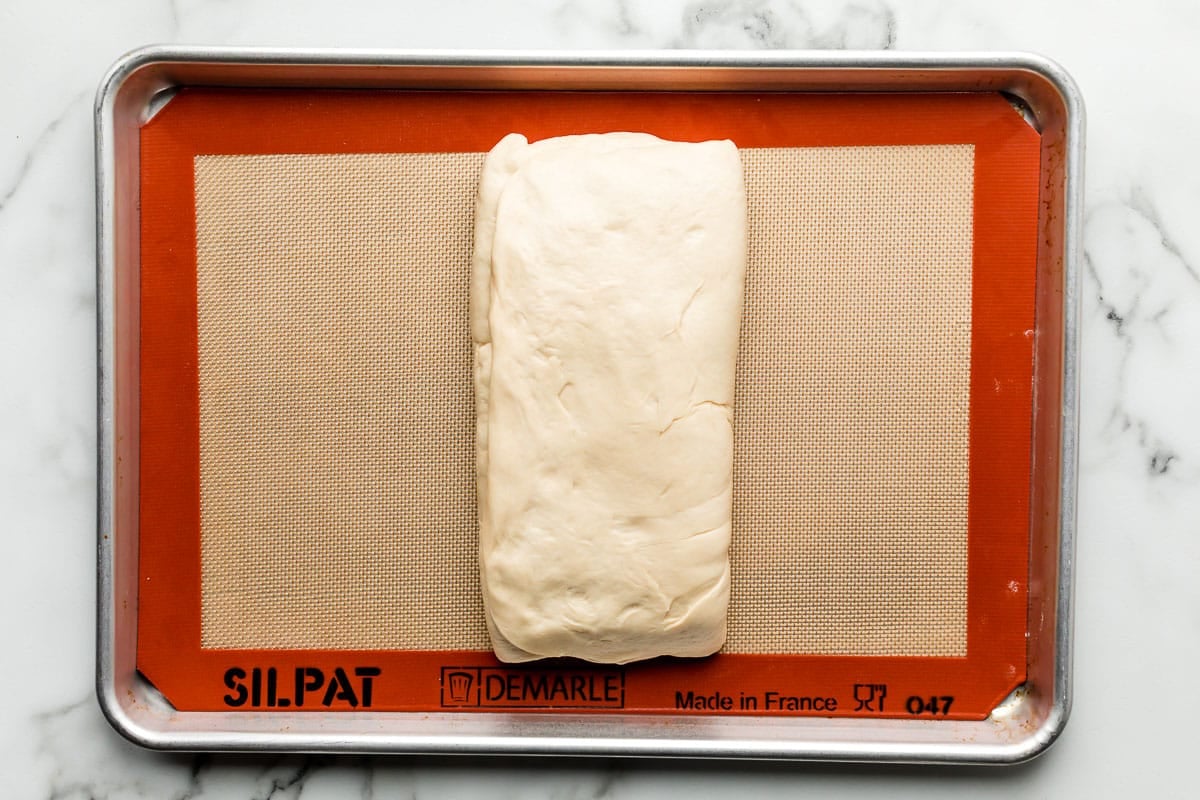
Rotate the dough so the long edge is facing you:
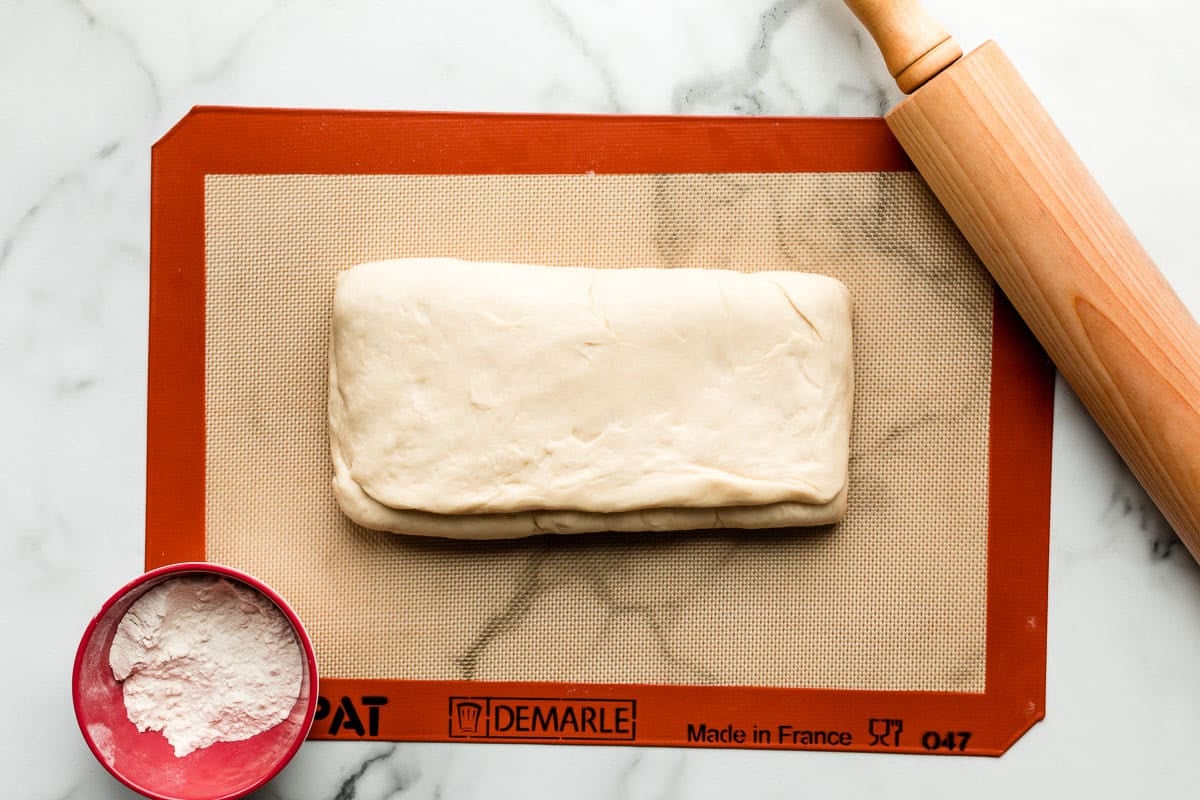
Roll out into a 9×12-inch (23x30cm) rectangle. You can see the butter hiding in there:
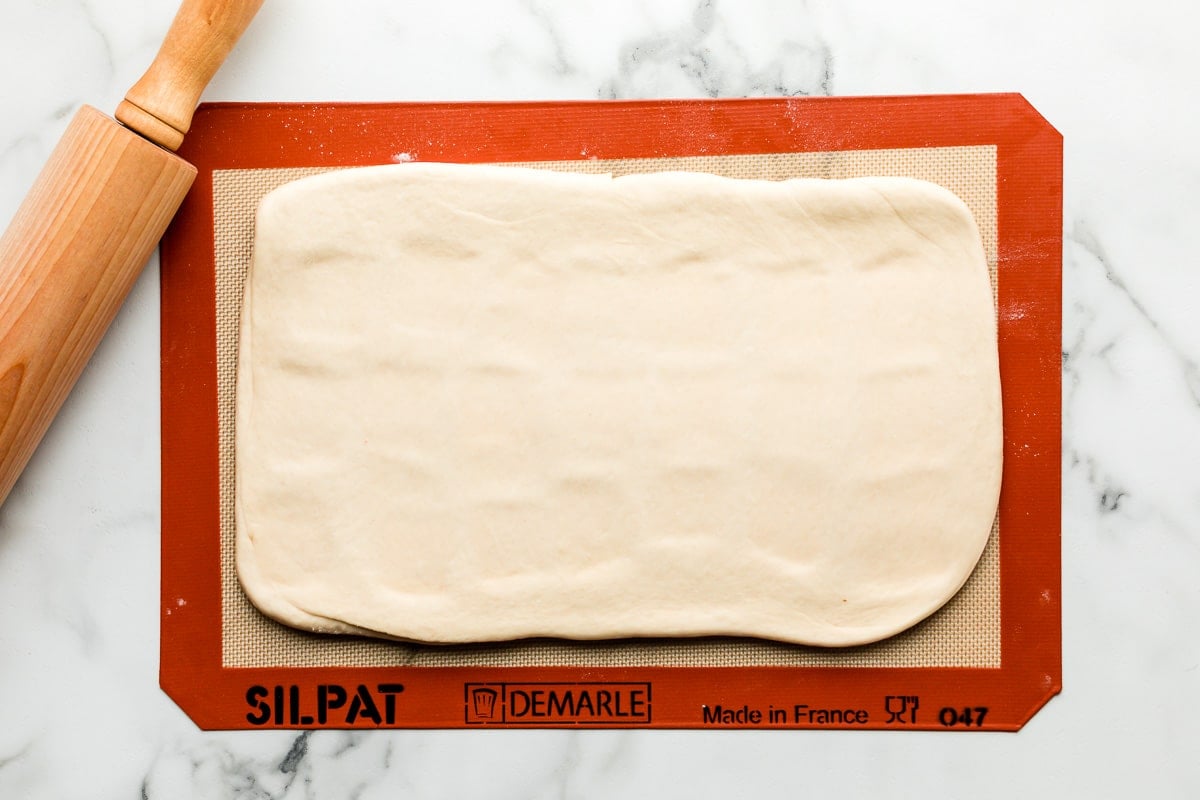
Fold up like a business letter, cover, and then chill for 20 minutes:
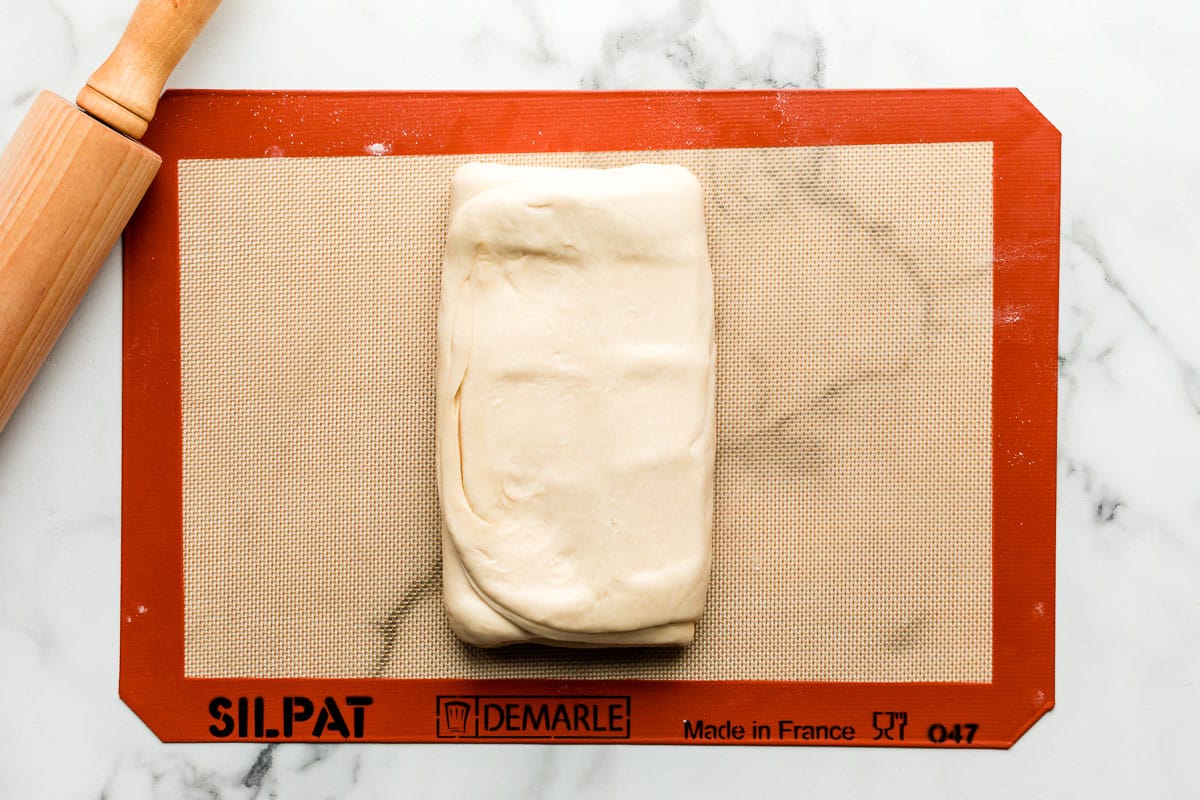
2nd & 3rd lamination: After refrigerating, repeat lamination process above 2x with no dough chilling between each—rotate dough, roll out, fold like business letter, rotate dough, roll out, fold like a business letter. And then chill 1 last time for 20 minutes.
Final lamination: After that final refrigeration, repeat lamination 1x. Then roll out the dough into a 9×12-inch (23x30cm) rectangle for the last time:
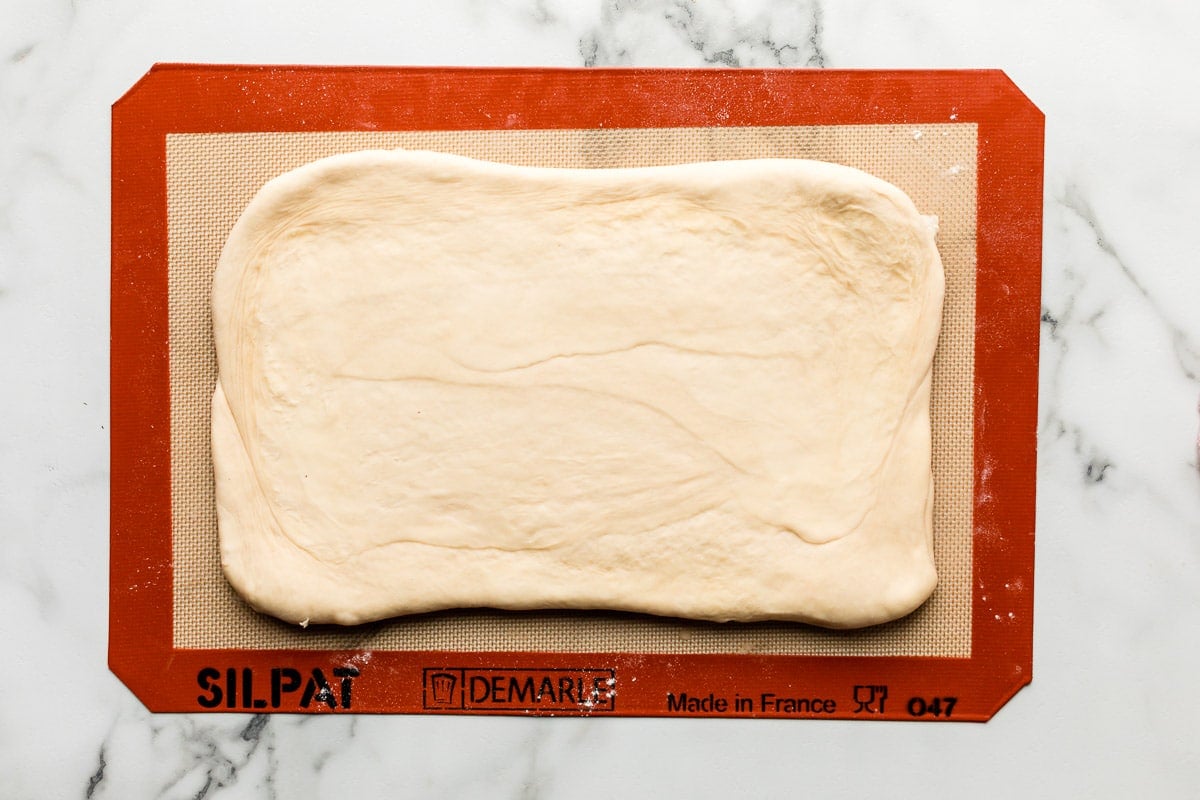
Roll it up like a jelly roll cake or cinnamon rolls dough, starting from the shorter end:
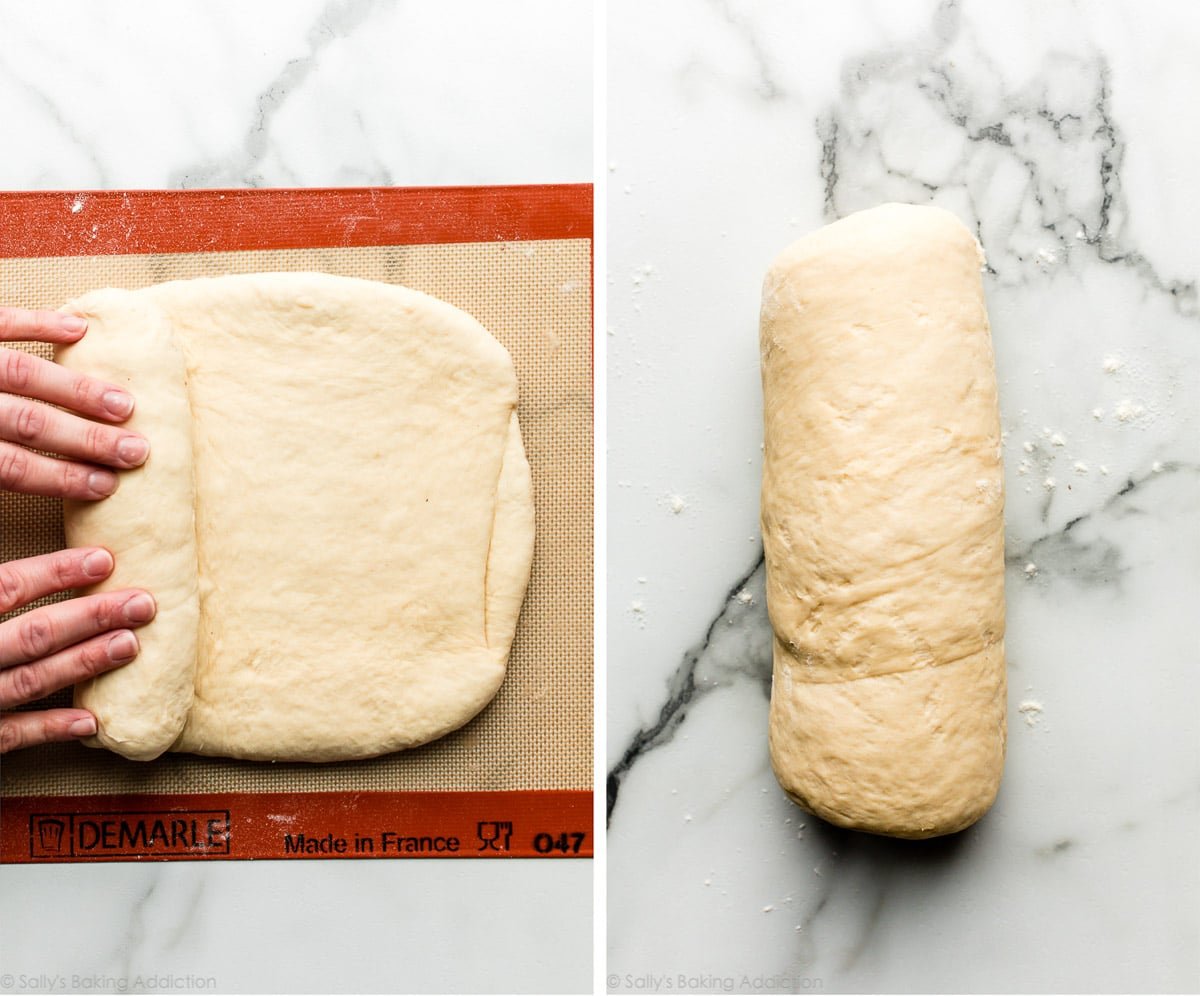
Slice into 5 thick rolls. Look at all those layers!
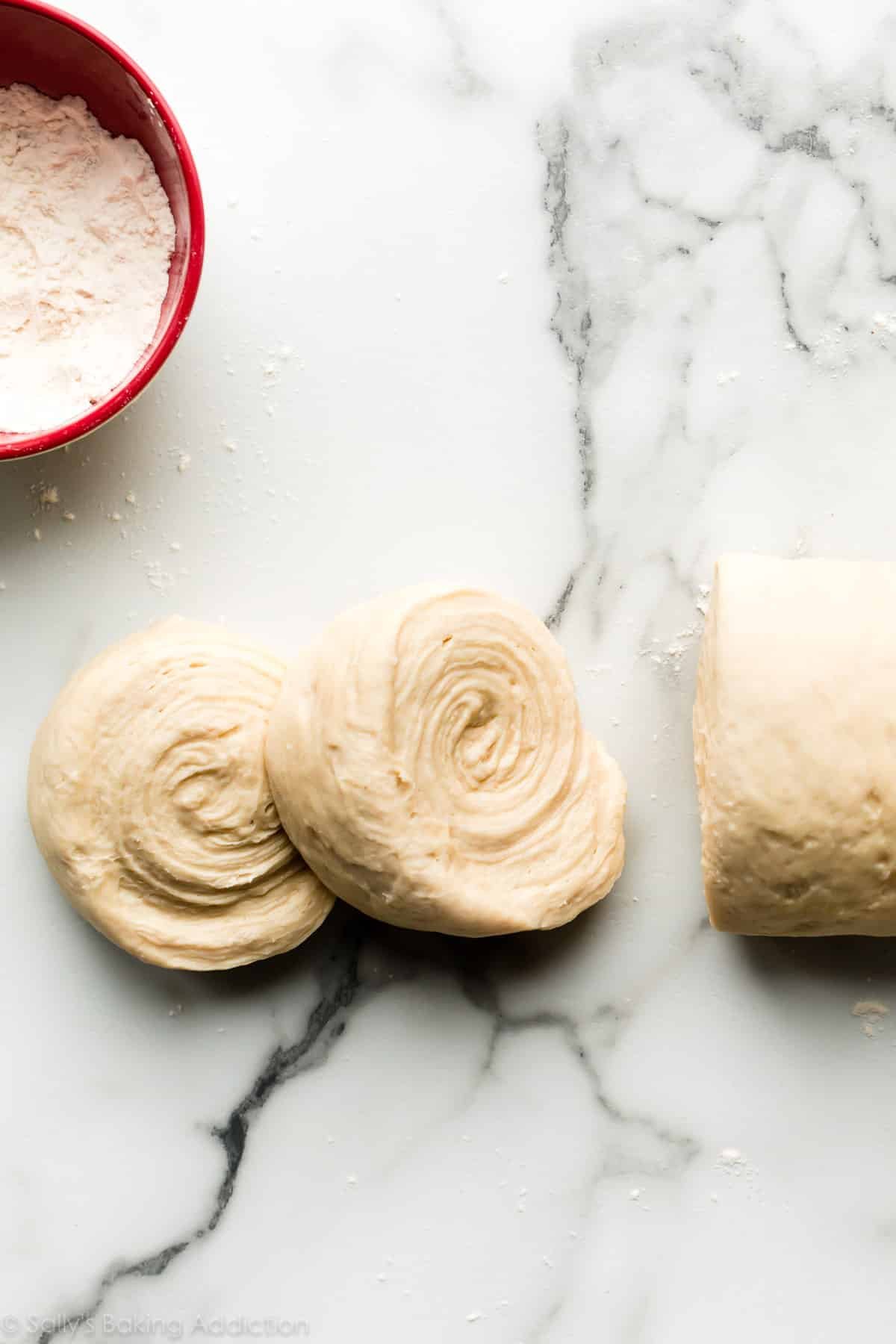
Arrange in a greased loaf pan, cover, and let rise until puffy. Then brush with egg wash before baking:
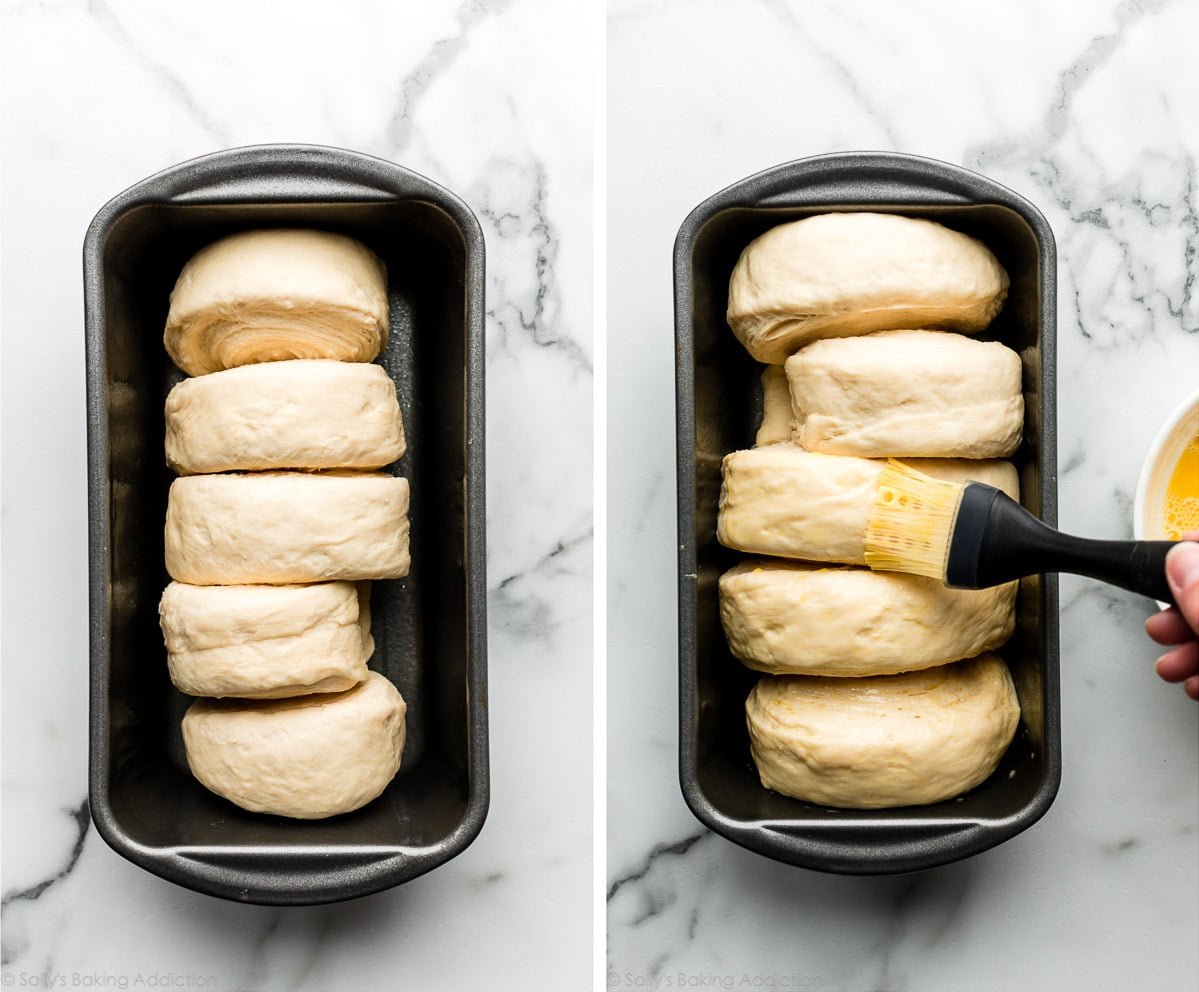
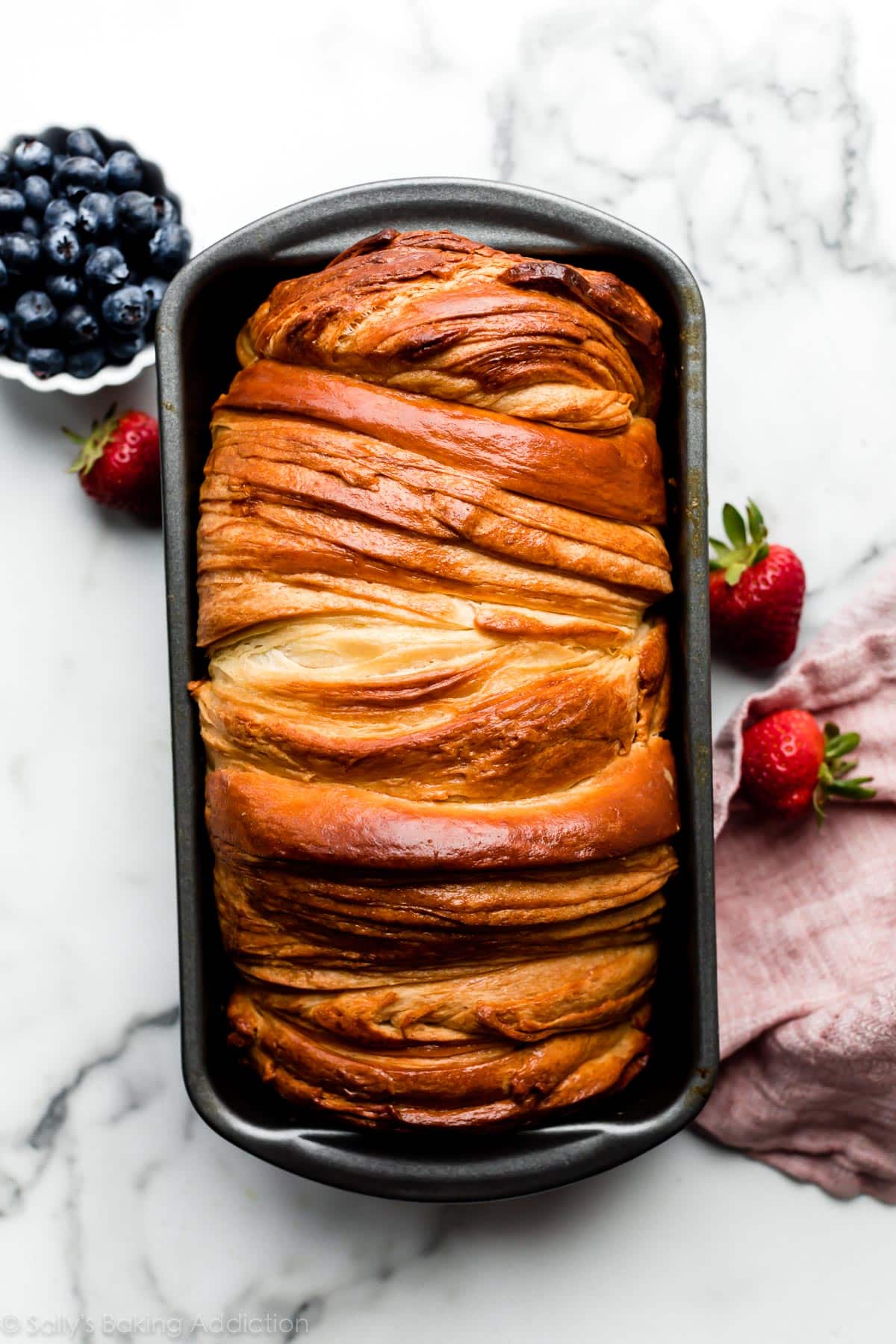

No Two Loaves Look the Same
Keep in mind that your loaf may look exactly like or slightly different from these photos. Despite following the exact same recipe and directions, some of my test loaves looked more airy, or less flaky, or more layered. You can see the variety in these photos. So don’t be discouraged if yours looks different… just wait until you TASTE it!
See Your Croissant Bread!
Feel free to email or share your recipe photos with us on social media. 🙂
Print
Croissant Bread (Loaf)
- Prep Time: 4 hours, 45 minutes
- Cook Time: 1 hour
- Total Time: 6 hours, 30 minutes (includes cooling)
- Yield: 1 loaf
- Category: Bread
- Method: Baking
- Cuisine: French
Description
Bakers of any skill level can use this thoroughly detailed recipe to make a beautifully flaky and golden brown loaf of homemade croissant bread. There are 3 rounds of 20-minute refrigerations. Do not break up the lamination steps and do not extend the refrigeration times because the dough will begin to over-expand.
Ingredients
Dough
- 1 cup (240ml) whole milk, warmed to about 110°F (43°C)
- 2 and 1/4 teaspoons (7g) instant or active dry yeast (1 standard packet, see Notes)
- 3 Tablespoons (38g) granulated sugar
- 1 and 1/4 teaspoons salt
- 3 Tablespoons (43g) unsalted or salted butter, softened to room temperature and cut into 3 equal pieces
- 3 cups (375g) all-purpose flour (spooned & leveled), plus more as needed and for lamination
Lamination
- 3/4 cup (12 Tbsp; 170g) salted butter, slightly softened (see Notes)
Egg Wash
- 1 large egg, cold or room temperature
- 1 Tablespoon (15ml) water
Instructions
- Preliminary notes: Watch the video tutorial and use the step-by-step photos before you begin. Read the recipe instructions and notes before beginning. Make room in the refrigerator for your half baking sheet for steps 6–9.
- Prepare the dough: In a large ungreased mixing bowl, whisk the warm milk, yeast, and sugar together in the bowl of your stand mixer fitted with a dough hook attachment. Cover and allow mixture to sit for about 5 minutes or until foamy on top. *If you do not own a mixer, you can do this in a large mixing bowl and in the next step, mix the dough together with a large wooden spoon/silicone spatula. A hand mixer works, but the sticky dough repeatedly gets stuck in the beaters. Mixing by hand with a wooden spoon or silicone spatula is a better choice.*
- Add the salt, butter, and 2 cups (250g) of flour. Beat on medium speed for 2 minutes, stopping and scraping down the bowl as needed to help the mixture combine. There may still be chunks of butter—that’s ok. Add remaining flour, scrape down the bowl as needed, and beat on low speed until a soft dough forms and pulls away from the sides of the bowl. Dough will be very soft, but not overly sticky. Beat in 2–3 more Tablespoons of flour if dough seems very sticky. Avoid adding more flour than you need.
- Knead the dough: Keep the dough in the mixer and beat for an additional 5 full minutes, or knead by hand on a lightly floured surface for 5 full minutes. (If you’re new to bread-baking, my How to Knead Dough video tutorial can help here.) If the dough becomes too sticky during the kneading process, sprinkle 1 teaspoon of flour at a time on the dough or on the work surface/in the bowl to make a soft, slightly tacky dough. Do not add more flour than you need because you do not want a dry dough. After kneading, the dough should still feel a little soft. Poke it with your finger—if it slowly bounces back, your dough is ready to rise. You can also do a “windowpane test” to see if your dough has been kneaded long enough: tear off a small (roughly golfball-size) piece of dough and gently stretch it out until it’s thin enough for light to pass through it. Hold it up to a window or light. Does light pass through the stretched dough without the dough tearing first? If so, your dough has been kneaded long enough and is ready to rise. If not, keep kneading until it passes the windowpane test.
- 1st rise: Lightly grease a large bowl with oil or use nonstick spray. Place the dough in the bowl, turning it to coat all sides of the dough in the oil. Cover the bowl with aluminum foil, plastic wrap, or a clean kitchen towel. Allow the dough to rise in a relatively warm environment for 1.5–2 hours or until nearly double in size. (For a tiny reduction in rise time, see my answer to Where Should Dough Rise? in my Baking with Yeast Guide.)
- Flatten dough: Punch down the dough to release the air. Place dough on a silicone baking mat-lined, parchment paper-lined, or lightly floured baking sheet. (I highly recommend a silicone baking mat because you can roll the dough out in the next steps directly on top and it won’t slide all over the counter.) Gently flatten the dough out into a 10×14-inch (25x35cm) rectangle using lightly floured hands to carefully stretch, but not tear, the dough. Lightly cover and place the entire baking sheet in the refrigerator, and allow the covered dough to rest and chill for 20 minutes. Do not extend this time.
- Meanwhile, prepare for lamination: Cut the salted butter into 1/4-inch thick slices and, as explained in the recipe note below, make sure the butter is not overly soft. It’s important to note the following 4 tips before you begin laminating in steps 8, 9, & 10: (1) It’s OK if there are air bubbles in the dough because your rolling pin will pop them. (2) If the dough tears and butter is exposed, just sprinkle the exposed butter with flour. (3) If the dough is impossible to roll, try flipping it over. If it’s still impossible to roll, cover and let it rest for 5 minutes before trying again, to let the gluten relax. And (4) Do not extend the refrigeration times, because the folded dough will begin to over-expand.
- 1st lamination: Remove dough from the refrigerator and set baking sheet aside. I like to keep the dough on the silicone baking mat when I’m rolling it because the mat is nonstick. Working with the longer (14-inch) edge in front of you, line butter down the center of the dough, covering the center third of the dough. Fold one dough edge over on top of butter, and fold other edge on top of that (like folding a business letter). Pinch/seal the two short ends to enclose butter inside. Rotate dough so the long edge is horizontally in front of you. Lightly flour the top of the folded dough and, using a lightly floured rolling pin, roll out to a 9×12-inch (23x30cm) rectangle. Fold dough edges over on top like folding a business letter. Cover dough, place back on baking sheet, and refrigerate 20 minutes. Do not extend this time.
- 2nd & 3rd laminations: Remove dough from the refrigerator and set baking sheet aside. Rotate dough so the long edge is horizontally in front of you. Lightly flour the top of the folded dough and, using a lightly floured rolling pin, roll out to a 9×12-inch rectangle. Fold dough edges over on top like folding a business letter. Rotate dough horizontally and repeat rolling out to 9×12 inches and folding like a business letter. Cover dough, place back on baking sheet, and refrigerate 20 minutes. Do not extend this time.
- Final lamination & shaping: Remove dough from the refrigerator and set baking sheet aside. Rotate dough so the long edge is horizontally in front of you. Lightly flour the top of the folded dough and using a lightly floured rolling pin, roll out to a 9×12-inch rectangle. Fold dough edges over on top like folding a business letter. For the last time, rotate horizontally and roll out to 9×12 inches. Working from a 9-inch side, roll dough up like you would roll up a jelly roll cake or cinnamon rolls. Place 9-inch log on a cutting board and cut into 5 even rolls (just eyeball it, they don’t need to be perfectly even).
- 2nd rise: Grease a 9×5-inch (23x13cm) loaf pan. Place rolls, seam side down, in loaf pan. Cover tightly and allow to rise until slightly puffy, about 45–60 minutes.
- Preheat the oven to 350°F (177°C).
- Whisk egg wash ingredients together. Generously brush risen rolls/loaf with egg wash. Bake loaf for 1 hour until golden brown on top, loosely tenting with aluminum foil after 25 minutes to prevent the top from over-browning before the center can cook. For an accurate test of doneness, the bread is done when an instant-read thermometer reads the center of the loaf as 195°F (90°C). (Tip: Keep in mind that the bread will continue to cook for a few minutes as it cools.)
- Remove from the oven and place loaf pan on a wire rack. Cool for 30 minutes in the loaf pan. Run a knife around the edges of the pan to release the bread, and then remove bread from loaf pan and cool at least 15 more minutes directly on a wire rack before slicing and serving. (Bread tends to fall apart when sliced warm.) Bread may slightly deflate as it cools.
- Storing & freezing baked bread: Cover and store leftover croissant bread covered at room temperature for up to 3 days or in the refrigerator for up to 1 week. You can also freeze it for up to 3 months and then thaw on the counter or overnight in the refrigerator. Warm up to your liking.
Notes
- Overnight Dough Instructions: After step 10, cover the shaped rolls in the loaf pan tightly and refrigerate for up to about 15 hours. At least 3 hours before you need the bread the next day, remove from the refrigerator, keep covered, and allow to rise on the counter for about 1–2 hours before baking. Alternatively, you can let the dough have its 1st rise (step 5) in the refrigerator overnight. Cover the dough tightly and place in the refrigerator for up to 12 hours. Remove from the refrigerator and allow the dough to fully rise for 2 more hours. Continue with step 6.
- Freezing Dough Instructions: The best way to successfully freeze and thaw this dough is after step 10. (Freezing/thawing before makes lamination difficult.) Cover and freeze shaped dough loaf (after step 10) for up to 3 months. Thaw in the refrigerator at least 3 hours before you need the bread, remove from the refrigerator, keep covered, and allow to rise on the counter for about 1–2 hours before baking.
- Special Tools (affiliate links): Ruler or tape measure | Silicone Baking Mat (optional but recommended) | Rolling Pin | 12×17-inch Half Sheet Pan | 9×5-inch Loaf Pan | Pastry Brush
- Milk: Whole milk is ideal, but you can swap a lower-fat or non-dairy milk. Avoid nonfat milk.
- Yeast: You can use active dry or instant yeast in this recipe. Follow all of the same instructions. If using active dry yeast, the rise times are usually *slightly* longer, but not much. Reference my Baking with Yeast Guide for answers to common yeast FAQs.
- Butter: You can use either unsalted or salted butter in the dough, but be sure to use salted butter in the lamination step. The butter in the dough can be softened to room temperature, even overly softened is fine. However, the butter for the lamination does require your attention. It’s important to make sure your lamination butter is not too cold/hard and you don’t want it too greasy/soft either, because it needs to be about as pliable as the dough to incorporate into it. Sometimes I use a cooking thermometer just to check what temperature my butter and dough are for the lamination step, and it’s ideal they both register *around* 60°F (15°C). Being about the same temperature helps the butter and the dough laminate easily.
- Can I Halve or Double This Recipe? No. Follow the dough recipe precisely as written. If 1 loaf is too much, freeze any extras. If you want 2 loaves, make the dough 2x separately.
- Can I Add a Filling? I tried jam and cinnamon sugar (1/4 teaspoon cinnamon with 2 Tbsp granulated sugar). The only one that worked fairly well was the cinnamon sugar. Anything wet like jam will create too much moisture and the bottom of the loaf doesn’t bake very well. Plus, you need quite a lot to really taste it, which makes rolling up the dough fairly messy and difficult. You can absolutely try adding something dry like the cinnamon sugar, chopped nuts, or even chocolate chips! Spread a thin layer on the dough before rolling it up into a log in step 10.
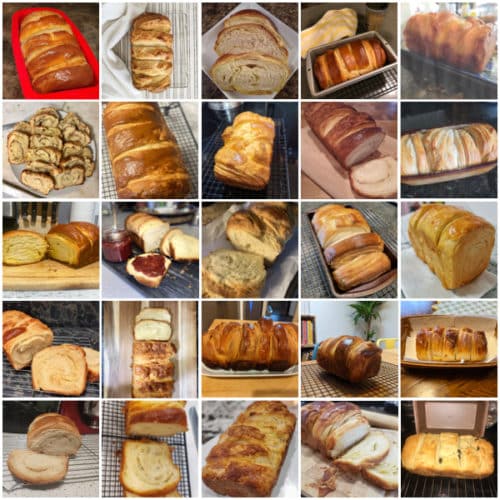
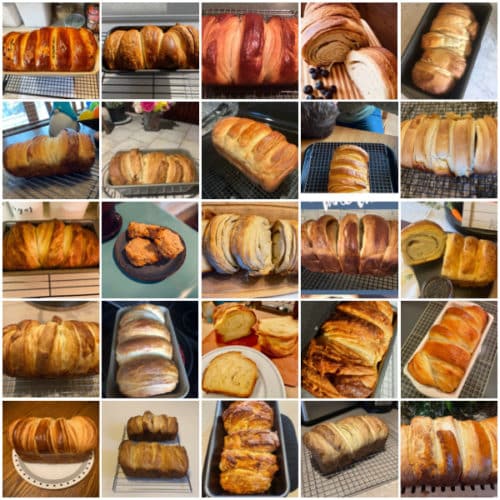
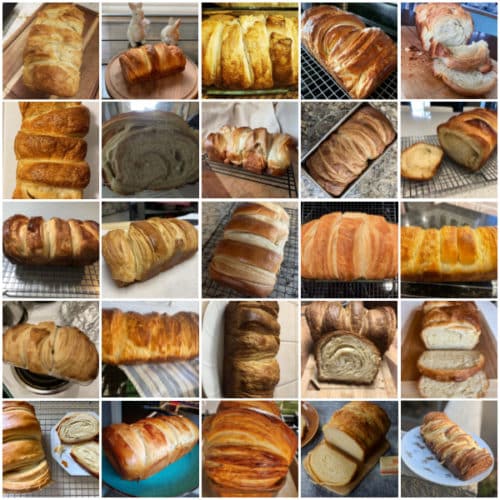
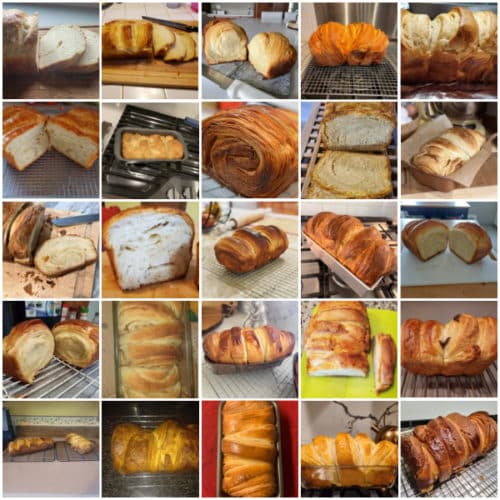
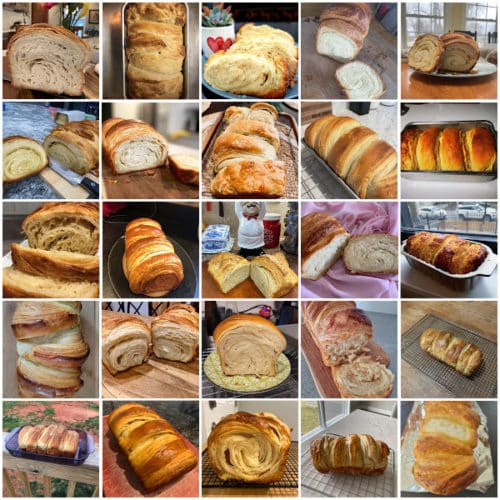
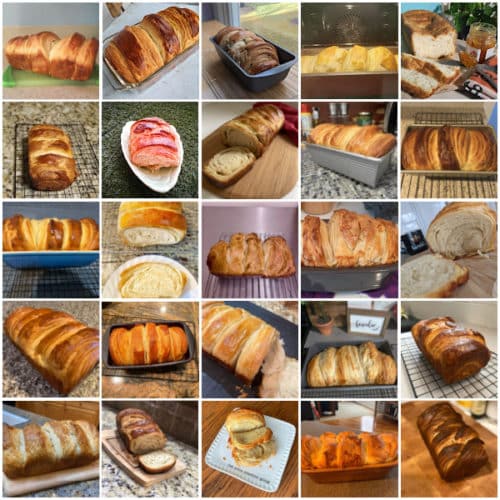
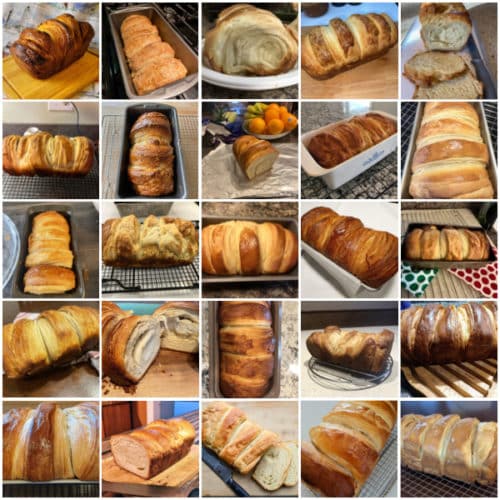

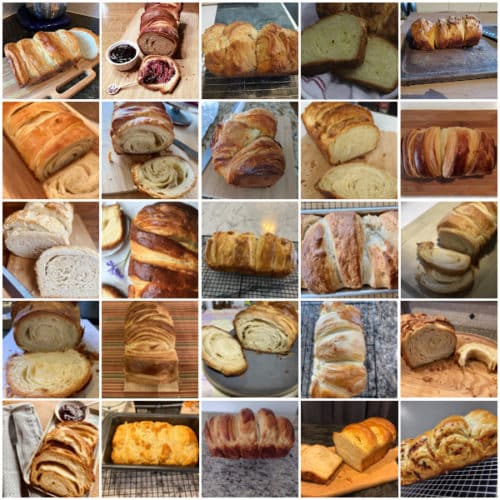
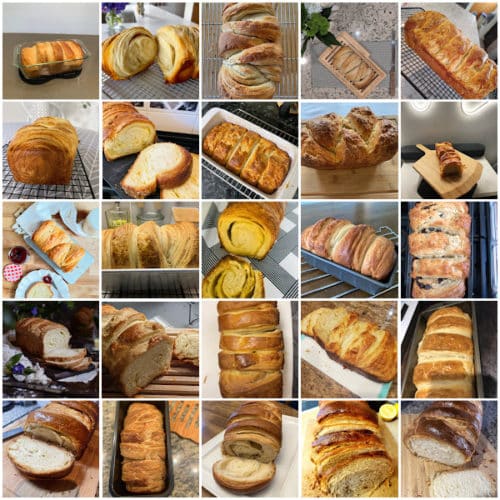
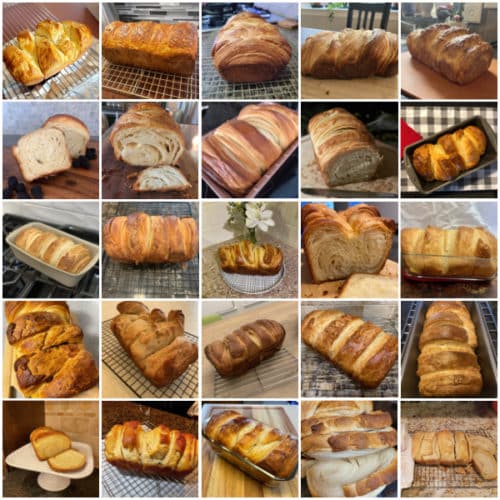

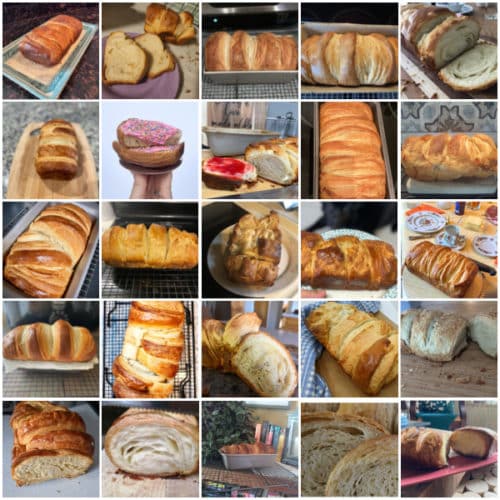
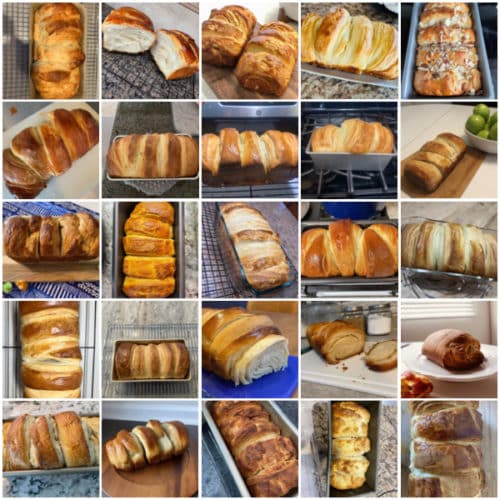
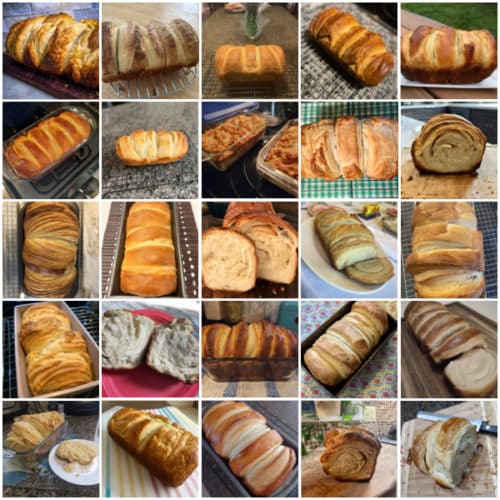
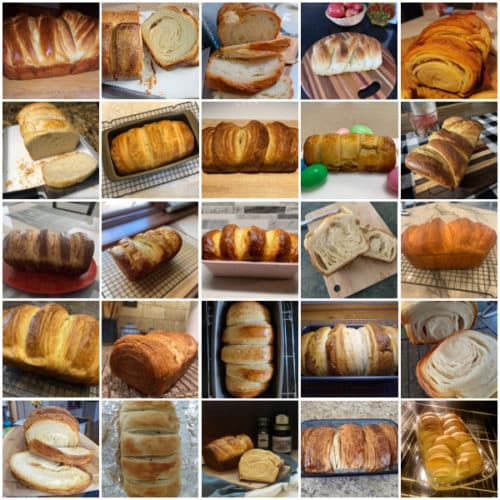
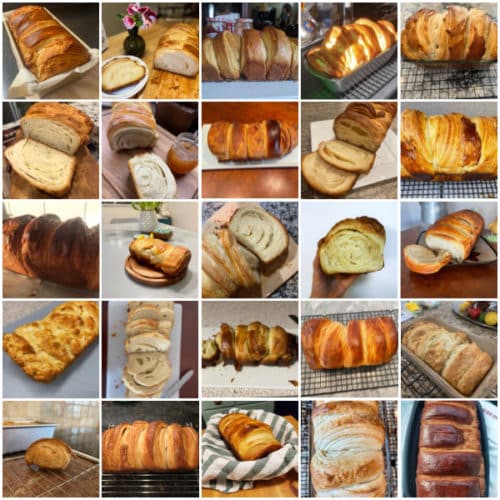
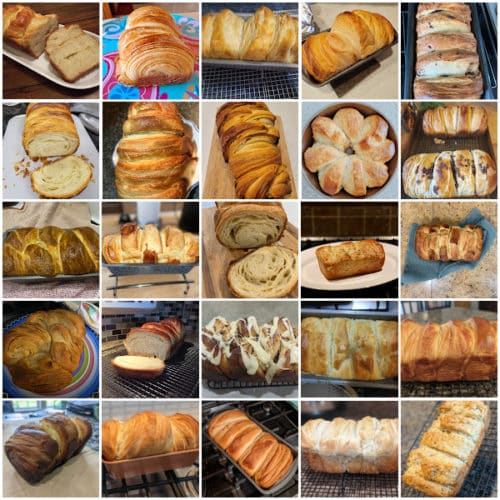
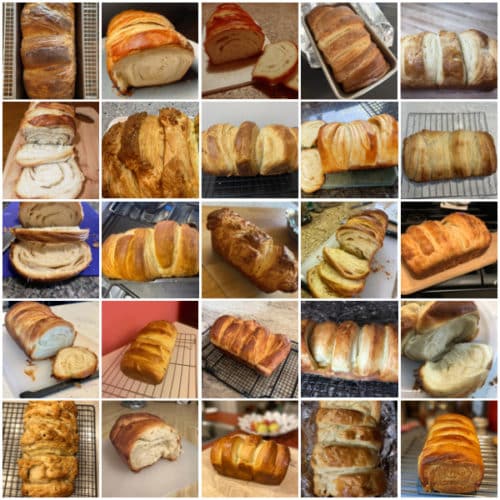
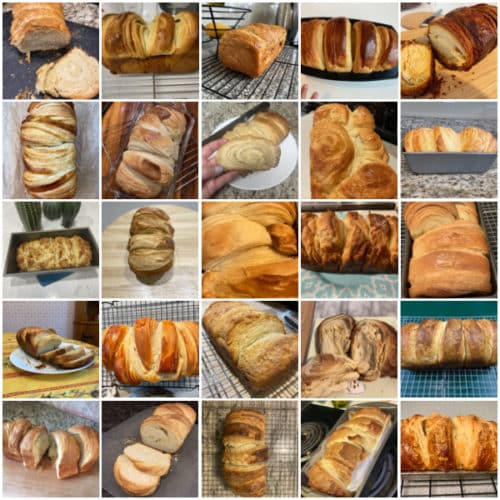
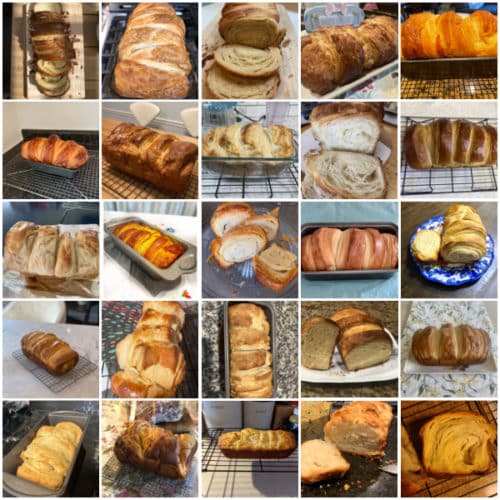
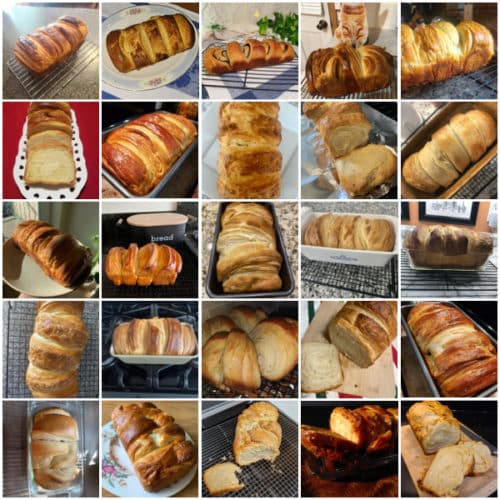
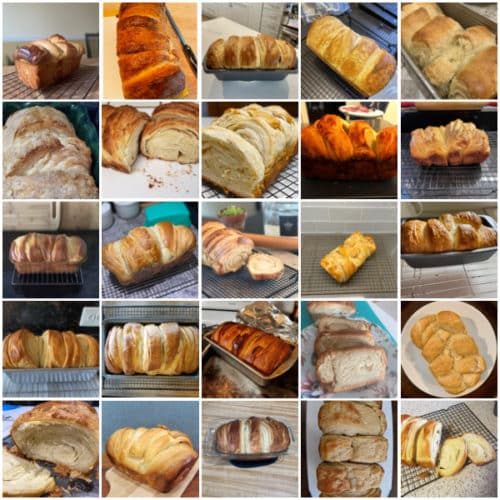
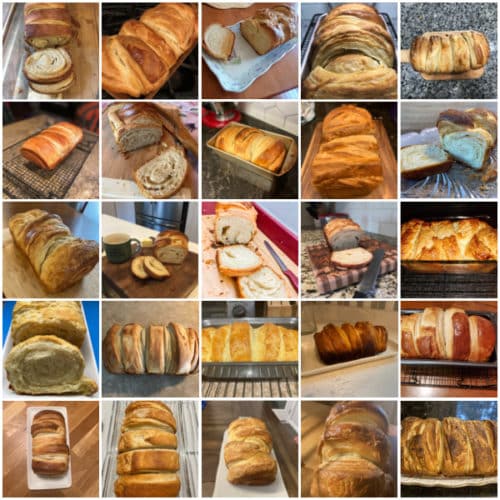
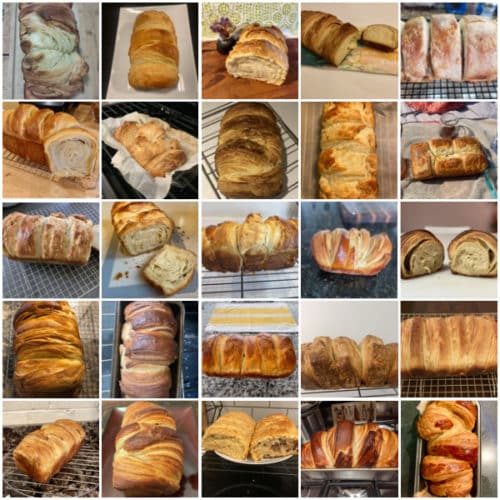
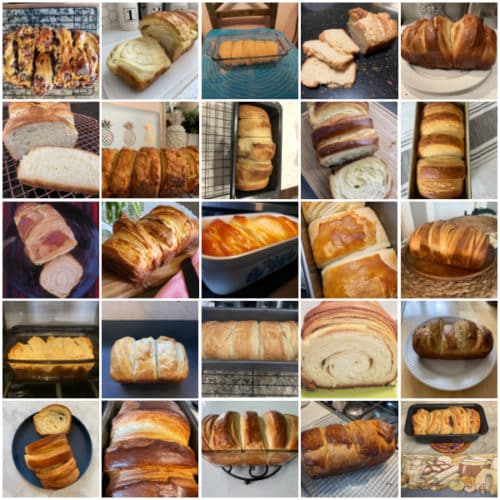

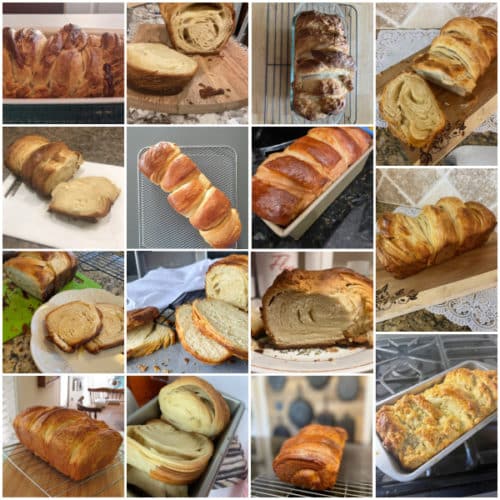



















This bread is amazing! Definitely going in my Sally’s top 10 recipes. My whole family couldn’t stop eating it.
Devine! So versatile too, made some amazing Ham and Cheese sandwiches that the family went crazy for. Made the house smell incredible too. We will definitely be making this again!
This recipe was so yummy! I think I definitely made some mistakes, the bread didn’t any pockets or visible layers, but it still tasted great. Very time consuming, but worth making!
The first time I made this my butter was too cold and I had difficulty with my laminating. It still turned out amazing though! Just a bit butter soaked and extra crispy at the bottom. The second time with warmer butter turned out much better! Loved the recipe so much.
Definitely a special occasion bread, but surprisingly easy to make. The video was super helpful if you’re not familiar with the lamination process. I also think the recipe is pretty forgiving— I made all sorts of mistakes and it was still great. My only suggestion is to listen to Sally’s tip about letting the loaf completely cool before cutting it otherwise it does sort of fall apart.
I followed all directions, but my dough was extremely dry and crumbly. I added more warm milk which held it together, but it was very dense and not soft. I kept going and the loaf actually turned out okay. What should I have done differently?
Hi Meg, thank you so much for trying the croissant bread! If you ever try the recipe again– see if you can go easier on the flour during the lamination steps. It’s possible there was just too much and it worked itself into the dough producing a denser texture. You could even extend both rise times, just to see if that helps as well.
This was such a fun process! It was an all day affair, but a fun one at that. The lamination process was so fun to see all the layers at the end. I will be keeping this in my “foods to impress” folder.
Wow! This bread is incredible and Sally’s detailed instructions and photos made it incredibly easy to make. Be prepared for the entire loaf to disappear immediately. The flaky texture and buttery flavor were absolutely perfect. My kiddos enjoyed it as a sweet treat with Nutella and sliced strawberries on top. I can’t wait to make it again!
I absolutely LOVED this recipe!! It had a sweet taste and was nice and buttery . I made it with whole wheat pastry flour and it turned out great! Thanks so much for sharing this recipe and making the directions easy to follow :))
Sally’s comment about testing the temperature of your butter and bread prior to laminating is something that shouldn’t be taken lightly! I let my butter go a little too soft and it was exploding out of my bread every time I rolled it out. Next time I will make sure that my butter is colder.
This was my first time joining a monthly challenge- it was such a fun process! Thanks, Sally!
This is so unbelievably delicious – better than any store-bought croissant I’ve ever had! It was a fun project to tackle during a day at home. A few suggestions for an otherwise excellent recipe: 1) I think it would be best to make a butter rectangle as prescribed in Sally’s croissant recipe. I sliced my butter into squares and it didn’t distribute evenly through the lamination process due to this. 2) My dough needed additional resting time between lamination steps. If I tried to roll it out twice after one rest it wasn’t cooperative. I added in some additional 10 minute resting periods and that helped immensely.
This was the first time I attempted the lamination procedure for baking. I was rewarded with a beautiful and delicious loaf of flaky, buttery deliciousness! The butter kept showing so I added flour, and the gluten kept pulling back after rolling, but I got there. I baked it just over an hour until the temperature was 190. The crust is perfect, but the center seems a little dense, still quite delicious. I had my first slice warm with Nutella. Heavenly!
Finally I found the time to complete this challenge, and I’m so glad I did!
The detailed instructions and video were so helpful!
The bread turned out so beautiful and so flavorful, I’m so happy with it!
Another amazing recipe from Sally. I have never made a laminated bread recipe but Sally’s instructions and video made the whole process easy to follow! It turned out beautiful and is so yummy!!I will definitely make this again!!
I loved the croissant bread. It was delicious! I was intimidated by it, but it was so easy. The only thing I had a problem with is that I didn’t grease the pan well enough and it stuck a bit. But it was still delicious! Thanks for another great recipe!
Wow. Wow! WOW!!! I was deeply suspicious throughout the process, including pulling the loaf out of the oven and cutting my first slices. But there was no disputing the incredible taste. My family devoured the loaf and demanded to know when they could expect another. Hopefully soon!
The recipe was well written. I appreciate all the pictures as it was especially helpful when my suspicious brain wanted to take over. I made the recipe exactly as written, including buying salted butter. When I make it again, I will not be making any type of tweaks, because why would you mess with perfection?!
Made this recipe the night I went into labor with my son so this bread will always have a special place in my heart now! Delicious and so satisfying to see the labor of your time and effort when you cut into the dough and see the beautiful lamination! Breads always make me a little nervous but as always Sally makes the recipe so easy to follow. Thank you for the fun and tasty challenge!
I’m trying to figure out why my loaf didn’t rise very much in the oven. I followed all of the steps and everything looked just like the photos up until it came out of the oven. I’m thinking it has something to do with the overnight option (after step 10). This morning I took it out of the refrigerator (it was in the refrigerator for about 14 hours) and let it rest on the counter for over an hour. Perhaps I should have let it rise more?
It still turned out delicious and I had a blast making it! Flakey and buttery! But I think I will try again and see if I can make it more like the photo. As always, thanks for the delicious recipes!
Hi Emilee! Did the bread seem like it had puffed a bit overnight and/or on the counter before baking? You want it to puff a bit before baking – you can see the blog post above for a visual. Usually this will take 1-2 hours, but could take more on a cooler day. Glad you still loved it!
Just made this bread yesterday and it was amazing. I’ve NEVER tried my hand at lamination before but this recipe made it less intimidating. Yes, time consuming but so worth it. I’ll be making this again and again.
I’ll admit I was very nervous about starting this challenge with my first recipe being a croissant…. but I truly enjoyed every part of making the recipe, including the “eating” part. So delish I’d definitely make it again.
Loved the video and detailed notes, had to reference them often to make sure I had all the steps and it worked…now if I could just remember to make dinner before I had indulged in the delicious croissant loaf first!
This was a lot of fun to make! Unfortunately I did not see the flaky layers and the bread was quite dense, but the taste is incredible!
It didn’t puff up in the twenty minute refrigeration period, and also didn’t puff much during the final rise before baking. I even tried the bread proof setting on my oven, which usually works quite well when I make bread.
I will definitely try again!
The taste is wonderful, so much so that my other half didn’t believe that I baked it. The best part of the recipe, for me, was the inclusion of temperature when the loaf was done.
This recipe turned out great! I did the overnight version and I don’t think it changed the outcome at all. It was a wonderful, flaky bread that I will definitely make again!
recipe request/suggestions
Savory cornbread cookies to serve with chili instead of cornbread.
We are serving chili for 250 people for a school event and want something that is easy to serve with the chili
I looked on your site before we started modifying the recipe but could not find anything
so we are starting to modify the following recipe
https://www.foodnetwork.com/recipes/valerie-bertinelli/sweet-and-savory-cornbread-cookies-3482842
Sounds delicious! Let us know how it goes, Kathleen.
This croissant bread is so buttery and delicious! I’ll be making it over and over again! The directions and video tutorial made it so easy to make.
The end result of this is super delicious and totally worth the hours of work. The only downside to this recipe is your family will want you to make it all the time! I would also suggest cutting the rolled dough into more than 5 pieces before putting them in the loaf pan to rise to make it easier to cut smaller pieces later.
This came out perfectly! For the butter, I cut all the butter of lamination slices while the dough in fridge first time after first roll out, put them on a plate and in fridge. Saves time and keeps butter from getting too warm. The thing I love about baking and Sally’s meticulous instructions is it give me a feeling of accomplishment when it works out and something to improve and study more when it doesn’t!
Now, if it didn’t take ALL day! I think it will make again the day before and refrigerate after step 10 if serving to guests
Super easy instructions to follow. The video was extremely helpful. I have never laminated before. I love that Sally’s monthly challenges have me doing something new. I was disappointed with how my layers turned out. They weren’t as flaky as I had hoped they would be. But I can always try again! The flavor was great. I love the buttery flavor, and it made my apartment smell amazing!
This was so much fun to make! We plan on incorporating these challenges into our homeschool and this was the first one. Everyone was quite pleased! My 8yo says the texture and taste were perfect. I’ve been intimidated by breads before but the video really helped.
Wow! I can’t believe how beautiful this loaf of bread looks like. Love the many layers from the lamination and with all the butter! Next time I may need to place a pan underneath the loaf pan since some of the melted butter dripped on the oven and caused the fire alarm to set off! Waving the fan to stop beeping was worth every wave! Ha! Thank you Sally for an awesome recipe. Smells incredible and can’t wait to try it!
This croissant bread is simply amazing! Light, buttery and so delicious. I’ve always wanted to make croissants and this was a great recipe to start with. The recipe was detailed which made the whole process enjoyable. I can’t wait to make it again!